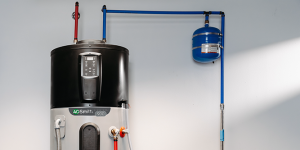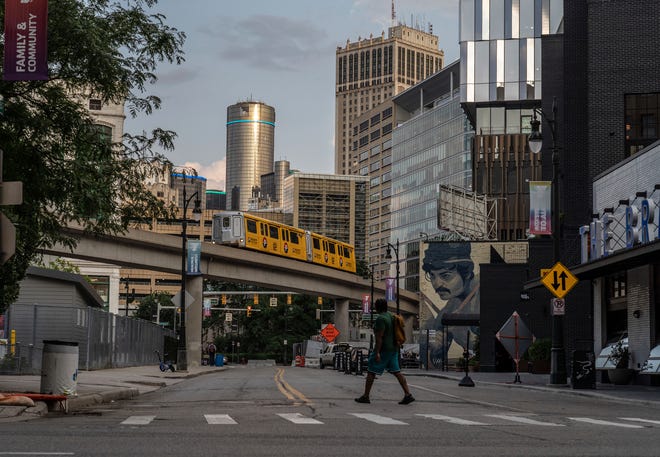To mark the 10-year anniversary of Detroit’s historic July 18, 2013, municipal bankruptcy filing, the Free Press is examining what has changed, what hasn’t, and why. Find more coverage atfreep.com.
Alease “Cookie” Moore loves her Cornerstone Village neighborhood.
It’s the simple things. Walking the streets, saying hi to neighbors sitting on their porches, planting crops at the community garden — beets, corn, sweet potatoes, herbs. She loves supporting the East Warren Farmers Market and local businesses like the Detroit Pepper Company, a Warren Avenue carryout spot that opened in 2019. She attends neighborhood meetings and advocates for her community as secretary of the Cornerstone Village Community Organization.
Moore thinks her neighborhood has seen some improvement compared with 10 years ago, when the city went broke, endured a grueling bankruptcy process and came out of it with a massive reinvestment plan.
But how much improvement? It’s hard to tell.
“I’ll put it this way — it started off better. But as time goes by, it’s lacking again. I don’t know what’s going on,” said Moore, 65.
Yes, there are more streetlights that actually work in her neighborhood, she said. And it seems like police are responding to neighbors’ calls a bit quicker.

But east-side neighborhoods like Moore’s are struggling with flooding. Blighted properties, trash dumped on vacant lots and other eyesores remain huge problems, according to Moore and other Detroiters.
When Detroit came out of bankruptcy with a 10-year plan to reinvest in services, the city was “gung-ho about doing street sweeping and cleaning, getting rid of blight. Not so much anymore,” Moore said, although in June the city promised to crack down on blight by suing landlords.
She wants to see promises fulfilled and efforts renewed to beautify Detroit neighborhoods.
“It makes people feel like they want to live here, want to do better to maintain it,” Moore said. “You get that ‘I love Detroit’ feeling. I was born and raised here, so I love it anyways.”
To help offer a clearer picture of exactly how much progress has been made since the historic bankruptcy filing in July 2013, the Free Press analyzed data on conditions and quality of life in Detroit, including police response times, violent crime rates, city budget health, population change, median home values, poverty rates, unemployment levels and high school graduation rates.
Thanks in large part to $466 million from local philanthropic foundations that didn’t want to see the collections of the Detroit Institute of Arts sold, a $195 million contribution from the state and, perhaps most painfully, retired city workers giving up a chunk of their pensions, the city exited bankruptcy in 2014 with a 10-year, $1.7 billion reinvestment plan.
Did it work? Are we better off?
Yes and no. Progress was clear in five of the metrics the Free Press analyzed, police response times, budget health, home values, poverty and unemployment rates. Figures in the other three areas were either disappointing, or complicated.
Here’s a look at the numbers:
Police response times and violent crime
Many Detroiters have just as bleak a view of city services as ever.
West-sider Winfred Blackmon, president of the Schaefer 7/8 Lodge Association, called neighborhood services “mediocre,” and emergency response times “inadequate.”
But the numbers indicate dramatic improvement in police response times for at least the most urgent calls.
In 2022, police responded to priority-one calls in 13 minutes, on average, far better than in 2012, when the city clocked an average of 30 minutes. Priority-one calls involve immediate danger, like shootings, assaults and robberies. Police in 2016 added to the priority-one category calls from Project Green Light, a surveillance program using cameras at participating businesses.
For non-priority-one calls, police took 11 minutes longer to get to the scene — 54 minutes on average — than a decade ago.
Still, many Detroiters like Blackmon continue to call out what they say are inequities in police response times in the city’s lowest-income neighborhoods.
Assistant Detroit Police Chief Charles Fitzgerald told the Free Press response time is a top priority for the department.
“In covering a city that is over 143 square miles, staffing decisions are made on a daily basis to improve response time,” he said.
EMS response has also improved. The Detroit Fire Department’s average response time for urgent ambulance calls is down to eight minutes, compared with 18 minutes in 2014, according to city officials. Staffing shortages led the city to sign an emergency contract with Universal Macomb Ambulance Service last month to shore up service. The fire department has been responding to building fires in just under six minutes on average so far this year, compared to seven minutes in 2014, according to the mayor’s office.
As for violent crime in Detroit, although it’s on the decline compared with last year, disturbingly high rates of incidence continue to be a challenge.
The rate of violent crime in 2012 was 2,150 incidents per 100,000 people. In 2022, it was 2,090 per 100,000 — nearly the same rate. Violent crimes include homicide, manslaughter, rape and assaults.
The rate has fluctuated over the last 10 years, according to the data from the FBI, the Detroit Police Department and the U.S. Census Bureau. The lowest rate came in 2015, when the city saw 1,759 violent crimes per 100,000 people. During the COVID-19 pandemic in 2020 and 2021, Detroit, along with cities across the country, struggled with a surge in violent crime. In 2021, the city reported 2,310 incidents per 100,000 people.
Detroit police recorded 333 homicides in 2013. In 2022, there were 309 homicides.

As of July 3 of this year, the city had recorded 126 homicides. Detroit police have partnered with state and federal law enforcement agencies and community organizations to help deter violent crime in Detroit. Fitzgerald said Detroit police set a goal of reducing violent crime by 10% by the end of 2023.
“We are dedicated to reducing violent crime every year,” Fitzgerald said.
Property crime in Detroit has decreased since 2013, although, like violent crime, the rate has fluctuated.
In 2012, the rate of property crime in Detroit was 5,868 reports per 100,000 people. In 2022, that rate had dropped to 4,643 per 100,000 people. Property crime was at its lowest in the city during the COVID-19 pandemic. In 2020, the rate was 3,314 per 100,000 people.
Detroit currently employs about the same number of police as it did in 2013. The city’s police force in 2013 included 2,457 officers. Today, 2,460 officers are employed, although the department has budgeted for 2,646 officers and expects to reach that number by the end of the year after approving pay increases for police, according to Sgt. Jordan Hall of the Detroit Police Department.
Prior to Detroit filing bankruptcy in 2013, the starting salary of police officers was about $29,000, according to the city. In 2022, the city came to an agreement with police unions to increase pay. Starting salary for a police officer has risen from $43,000 a year to $53,000; those with more than four years of experience have had their salaries increased from $60,000 a year to $73,000; the salaries of detectives increased by $11,000, sergeants got an average boost of $10,000 and lieutenants saw an average raise of $11,000.
Officers will receive annual salary increases of 4%.
City budget health
Detroit’s financial health was dismal in the run-up to the bankruptcy.
The city was simply spending more than it could bring in, hobbled primarily by crippling debt service obligations, which the bankruptcy eased.
With the help of debt relief, increases in income tax collection, online gaming revenue and other sources of money, the city has since managed to establish healthy reserves, including a rainy day fund and an additional fund to help pay its retirees. Under state law, the city’s budget reserve is required to hold at least 5% of its projected recurring expenditures each fiscal year to cover a potential financial disaster or reduction in revenues. Detroit’s reserve was 11% of its expenditures in its latest adopted budget.
“Right after the bankruptcy, revenues certainly stabilized, and we’re starting to show some modest growth,” said Detroit Budget Director Steve Watson. “It was in the years just prior to the pandemic, income taxes really started to take off and show much more robust growth … where the bankruptcy assumed somewhere around a 2% growth rate per year in revenues, we’ve instead vastly exceeded that.”

At the end of the 2022 fiscal year, city income tax revenue was about $400 million — up from less than $250 million in 2014. The bankruptcy plan of adjustment — the court-approved document that charted a path forward as the city exited bankruptcy in 2014 — assumed that income tax revenue would be about $300 million in 10 years, Watson said. Increased revenues generated a surplus, which is now funding various initiatives, while allowing money to be set aside for rainy day and retiree protection funds. Watson said the developments have put the city in a stronger financial position in the long term.
Detroit’s reserve balance is expected to hold $150 million by June 30, 2024, which marks the end of the fiscal year. In the early post-bankruptcy years, the reserve balance shrunk nearly in half from fiscal year 2015 to 2016, but has steadily grown since 2018.
The bankruptcy gave the city a 10-year break from paying into its retiree pension fund, but the honeymoon is over, and annual payments of about $134 million will put pressure on the budget, which makes having cash on hand key to weathering any future crises, said James Tatum, researcher for the Citizens Research Council of Michigan.
“Fundamentally, fiscal crises are crises of inadequate cash on hand … because if I can’t pay my vendors, if I can’t make payroll, if I can’t make that payment, well, those are all financial failures. That’s indicative of disarray,” Tatum said.
Cash can be measured by days. At the end of fiscal year 2013, Detroit’s general fund had $3.7 million in cash on hand, or less than two days’ worth of expenditures, according to the Citizens Research Council. At the end of the 2022 fiscal year, Detroit reported more than $544 million in cash on hand, or more than 200 days’ worth of expenditures.
Population
Detroit’s population reached its peak in 1950 with more than 1.8 million residents. Latest U.S. census figures indicate the city has since lost two-thirds of its residents, with a 2022 estimate of 620,376 and no sign of recent growth.
Mayor Mike Duggan’s administration has challenged the bureau’s results in federal court, alleging Detroiters are being undercounted. The mayor, now in his third term, said soon after taking office during bankruptcy proceedings in 2013 that his tenure should ultimately be judged by one standard: population growth.
“The mayor does believe the best measure of success is whether the population of the city is going up or down. Both the U.S. Post Office and DTE (Energy) official records show a growth of at least 6,000 new occupied residential units over the last two years,” said John Roach, Duggan’s spokesman. “The U.S. Census Bureau has just provided us the backup detail to their estimates, and based on that review, we are very confident we have identified the major errors in their methodology and will prevail in our appeal.”
Potential undercounting aside, regaining population in Detroit will require more from the city as far as strengthening its school system, growing its labor force and addressing the high cost of living and taxes, said demographer Kurt Metzger, founder of nonprofit Data Driven Detroit.
“I don’t think the city is ever going to get back to 1 million unless we build a lot of new densely packed housing. Detroit’s peak population … was at a height of overcrowding in neighborhoods,” Metzger said. “You don’t have to have 1 million people to be successful if you have employment, strong neighborhoods, strong business and entrepreneurship and hopefully an improved school system. We use population as an indicator of whether a city is successful. We definitely have to get population growth. We’re not going to stabilize at 630,000.”
Metzger, who sits in on meetings with Duggan about population, added that Detroit officials should aim to grow to 750,000 residents in the next 20 years.
Crime continues to hinder population growth, Metzger added, along with a limited public transit system. One source of hope: new state laws allowing for criminal record expungement that could boost employment opportunity in the city.
“Programs that are expunging (criminal) records on job applications, combined with skills training and increased apprenticeships, will go a long way to reduce crime by giving men in their late teens and early 20s hope and meaning,” Metzger said.
Home values
It wasn’t exaggeration or urban myth.
Buyers were picking up houses for the price of a cheap couch in areas of Detroit following the Great Recession.
Those bargain basement prices helped deflate the median owner-occupied home value to just under $43,000 in 2013. That’s according to U.S. census estimates in 2021 dollars from the annual American Community Survey.
But the rebound has been considerable, experts say, with help from an overall real estate market recovery paired with Detroit’s post-bankruptcy reinvestment in basic city services stirring more demand.
The most recent estimate shows that median owner-occupied home values rose to $69,300 in 2021, a nearly 62% increase since 2013. (The data is based on survey respondents’ estimates of how much the home is worth.)
“It continues to grow,” said Alex Lauer, a Detroit resident and broker with Clyde Realty. “I am seeing neighborhoods that five years ago I would have been shocked if you would have told me some of the price points that were coming in it.”
Statewide, the median owner-occupied home value is just above $199,000, a 46% increase since 2013.
Traditional market sales have outnumbered “distressed” sales in Detroit that were so common in the years after the 2008 housing crash, said Ashley Williams Clark, vice president of Detroit Future City, a nonprofit think tank focused on revitalization strategies in Detroit. A distressed sale typically includes mortgage and tax foreclosures, which can sell at reduced prices.

“There are neighborhoods where you couldn’t sell your house for more than what you bought it for,” he said. “Say you wanted to pull some money out of your house and put your kid through college, you couldn’t do it. Now, that’s something you can do. Or you can leverage your house to buy another house.”
Lauer said many neighborhoods are on such an upswing that he expects developers to build infill housing next. Only eight new single family homes were built in Detroit in 2022, according to the mayor’s office.
New mortgage loans in Detroit still remain low compared with other cities, according to research by Detroit Future City, with only 3,211 home purchase loans made in 2022. And Black applicants were denied home loans in the city at twice the rate as white applicants, the group found in 2020.
Williams Clark said it’s important to make sure the city continues to have a “diversity of price points,” where a wide range of people can buy into the American Dream of homeownership.
“So that people who are existing residents and other residents can benefit from that wealth creation, but there is also still opportunity for people to have access to those homeownership dreams and goals,” she said.
Poverty
Detroit has seen major gains in its households moving out of poverty.
So much that it has surpassed the improvement in most large industrial cities in the Midwest and Northeast since 2012, researchers say. One expert went as far as to call the progress “remarkable.”
“This is real success,” said Luke Shaefer, director of Poverty Solutions, an initiative at the University of Michigan that partners researchers, policymakers and community members toward alleviating poverty. “That’s transformational.”
In 2013, 40.7% of Detroiters were considered living below the poverty line, according to the U.S. Census estimates from the annual American Community Survey. But that number dropped to 30% as of 2021.
The poverty line for a family of four was an income below $27,740 a year in 2021, according to the census.That 30.2% rate in 2021 still makes Detroit the poorest large city in the nation.
But Shaefer said he still thinks Detroit’s improvement is considerable, in part because the poverty rate increased nationwide and in similar cities between 2019 and 2021, while Detroit continued to see progress.
Nearly 75,000 fewer Detroiters were living in poverty in 2021 compared with 2012, he said. Much of that was due to income increases in low- and middle-income families, research shows.
What has worked?
“I just think there is a lot of positive momentum in the city in terms of coming together and practically solving the problems that we have,” Shaefer said. “Give credit to the (Duggan) administration for putting a major focus on jobs in the city.”
Shaefer and others say much more work must be done, though. Statewide, the poverty rate was 13% in 2021.
“There are still way too many people in poverty (in Detroit),” said Ted Phillips, executive director of the Detroit-based United Community Housing Coalition. “We still need to find a way to deal with those that are still there and not treat this as a victory lap.”
Unemployment
Just a few months before the 10-year anniversary of the bankruptcy filing, the mayor’s office announced the city’s unemployment rate had dropped to its lowest level since the Bureau of Labor Statistics started tracking monthly jobless levels in the city in 1990.
Detroit’s unemployment rate in April was 4.2%, according to BLS figures. That rate has risen slightly since then, to 6.4% in May, but is still much lower compared with an average rate of 18.8% in 2013.
Other recent studies of Detroit’s labor market, though, paint a different picture, complicating the analysis of Detroit’s economic recovery since the bankruptcy. Factor in the COVID-19 pandemic, which led to widespread layoffs, and assessing the city’s recovery becomes even more complicated.
Many experts say, and data and surveys show, that Detroit’s labor market has improved since the bankruptcy.
The number of Detroit residents who are considered unemployed has dropped to an average of 19,725 in 2022, a 59% improvement compared with the average of 48,512 city residents who were unemployed in 2013, according to BLS data.
However, economists and researchers say how unemployment is being defined is important. For example, University of Michigan’s Detroit Metro Area Communities Study finds Detroit’s unemployment rate was 16% in March when including a group called “labor force rebounders:” residents who are retired, disabled, students, have family or personal obligations or otherwise choose not to work, but report actively searching for a job in the past month. This group of residents in other surveys may not be considered unemployed because they chose not to work and weren’t laid off recently.

DMACS’ surveys show that the jobless rate has improved from the beginning of the COVID-19 pandemic — when unemployment spiked to 43% — and from September 2021, when DMACS said the jobless rate in the city was 25%. The jobless rate is still higher, though, than its estimated pre-pandemic unemployment rate of 8%.
Lydia Wileden, author of the University of Michigan DMACS report, said the differences between BLS and DMACS data “suggests something about the employment situation is potentially being missed.”
High school graduation rates
While Michigan’s four-year graduation rate has hovered around 80%, Detroit’s has continually lagged behind.
Just before Detroit filed for bankruptcy in 2013, 64.6% of Detroit Public Schools seniors graduated, according to state data, compared with 77% of Michigan seniors. The school district’s four-year graduation rates for students has since ticked up to a high of 78.3% in the 2015-16 school year, and dropped again to 64.5% in 2020-21, at the height of the coronavirus pandemic, as students struggled to show up to school in-person.
And, of the Detroit students who graduated in the class of 2013, about 64% attended college their first year out of high school, but fewer earned degrees. After five years, 14% had earned a four-year degree and nearly 3% earned a two-year degree. Statewide, about 25% earned a four-year degree after five years and 6.5% earned a two-year degree.
The district, by 2013, had already undergone its own financial free-fall as enrollment in the state’s largest district fell in the early 2000s, from nearly 170,000 students in 2000 to nearly 50,000 in 2015, according to state data.

Detroit spent more than a decade under state oversight, with a virtually powerless elected school board, starting in 1999. In 2016, Gov. Rick Snyder signed a $617 million state bailout of the district. The deal restructured the district into two entities: One retired district to exist for debt retirement, and a new community school district with a locally elected board and revenue to operate.
District Superintendent Nikolai Vitti, who took the helm in 2017, has touted academic progress since then, including improved attendance. However, the pandemic set students back considerably, and Detroit continues to rank last among major city school districts in reading and math scores.
‘What about the neighborhoods?’
It’s difficult for many Detroiters to rejoice in the progress that has been made, with much left to be desired.
Karen Knox, an east-sider and executive director of the Eden Gardens Community Association, has noticed that police have been quicker to respond in emergencies, and there are far more working streetlights since the bankruptcy.
But she said she isn’t seeing enough businesses opening, or houses being built in lots where blighted properties were demolished. Illegal dumping, flooding and blight persist. She has seen long wait times for buses, and crime remains a top concern.
“Where did the money go?” asked Knox, 62. “Downtown is booming, but what about the neighborhoods? … No one is talking to neighborhoods and asking them what they want — look how we’re living.”
It’s a familiar sentiment. Detroiters were making the same complaints 10 years ago. But the tone is different. There doesn’t appear to be the same level of anger and desperation. And with poverty and unemployment way down, home values up and a city budget with some breathing room, the outlook appears far less bleak.
Read the full article here














